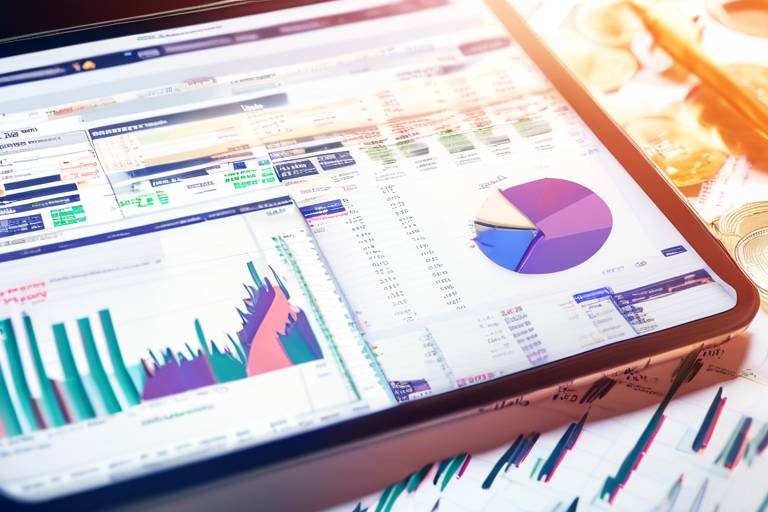The Best Indicators for Day Trading
Day trading is an exhilarating yet challenging endeavor that requires not only a keen understanding of the markets but also the right tools to navigate them effectively. In this fast-paced environment, where every second counts, having the best indicators at your fingertips can make all the difference between profit and loss. But what exactly are these indicators, and how can they help you in your trading journey? Let's dive deeper into the world of day trading indicators and discover the most effective ones that can elevate your trading game.
At its core, day trading indicators are analytical tools that assist traders in evaluating market trends and price movements. These indicators provide valuable insights that can guide decision-making in real-time, enhancing trading strategies and outcomes. Think of them as your trading compass, helping you navigate through the often turbulent waters of the stock market. By leveraging these indicators, you can make more informed decisions, ultimately leading to better trading results and increased profitability.
There are various types of indicators used in day trading, each serving a unique purpose. Understanding these indicators is crucial for refining your trading strategies. The main categories include:
- Trend Indicators: These indicators help you identify the direction of the market, whether it’s moving upward or downward.
- Momentum Indicators: These assess the speed of price movements and are essential for spotting potential market reversals.
- Volatility Indicators: These measure market fluctuations, helping you gauge the risk associated with a trade.
Trend indicators are vital for any day trader, as they allow you to identify the market's direction. By recognizing whether the market is trending upward or downward, you can make more informed decisions about when to enter or exit positions. For instance, if a stock is on an upward trend, it may be wise to buy, while a downward trend might signal a sell. Two of the most popular trend indicators are:
Moving averages are one of the simplest yet most effective trend indicators. They smooth out price data over a specific period, allowing you to identify trends more easily. By analyzing moving averages, traders can determine optimal entry and exit points based on market momentum and direction. For example, a trader may look for a crossover of the short-term moving average over the long-term moving average as a buy signal.
The ADX is another powerful trend indicator that measures the strength of a trend. It helps traders ascertain whether to follow or avoid a particular market direction. A higher ADX value indicates a stronger trend, which can guide your trading decisions effectively. For instance, if the ADX is above 25, it suggests a strong trend, while a value below 20 indicates a weak trend.
Momentum indicators are essential for assessing the speed of price movements. They play a crucial role in identifying potential reversals and continuations in the market, enabling traders to capitalize on short-term price fluctuations. One popular momentum indicator is the Relative Strength Index (RSI), which measures the speed and change of price movements. An RSI above 70 indicates that a stock may be overbought, while an RSI below 30 suggests it may be oversold.
Volatility indicators are vital for understanding market fluctuations and the potential risks associated with trades. They help traders set stop-loss orders and manage overall trading risk effectively. Two widely used volatility indicators include:
Bollinger Bands consist of a moving average and two standard deviation lines. They help traders identify overbought or oversold conditions, providing insights into potential price reversals and breakout opportunities. When the price touches the upper band, it may indicate that the asset is overbought, while touching the lower band may suggest it is oversold.
The Average True Range (ATR) measures market volatility by calculating the average range between high and low prices over a set period. This indicator assists traders in determining optimal position sizes and setting stop-loss levels, ensuring that they manage their risk effectively. A higher ATR value indicates greater volatility, suggesting that traders should adjust their strategies accordingly.
Q: What are day trading indicators?
A: Day trading indicators are analytical tools that help traders assess market trends and price movements to make informed trading decisions.
Q: How do I choose the right indicators for day trading?
A: The right indicators depend on your trading style and strategy. It's essential to experiment with different indicators and find the ones that suit your needs best.
Q: Can I rely solely on indicators for day trading?
A: While indicators are valuable tools, it's crucial to combine them with sound risk management and a solid trading plan for the best results.

Understanding Day Trading Indicators
Day trading indicators are the essential tools that help traders navigate the often turbulent waters of the financial markets. Think of them as your personal compass; they guide you through the chaos of price fluctuations and market trends, allowing you to make informed decisions in real-time. In a world where every second counts, having reliable indicators at your disposal can mean the difference between a profitable trade and a costly mistake.
These indicators come in various forms, each serving a unique purpose. They analyze market conditions by examining price movements, trading volumes, and market trends. By interpreting these signals, traders can better understand whether to buy, sell, or hold their positions. The beauty of day trading indicators lies in their ability to condense vast amounts of data into actionable insights, effectively simplifying the decision-making process.
To break it down further, day trading indicators can be classified into three main categories:
- Trend Indicators: These indicators help identify the overall direction of the market, allowing traders to align their strategies accordingly.
- Momentum Indicators: These assess the speed of price movements, helping traders spot potential reversals or continuations.
- Volatility Indicators: These measure market fluctuations, providing insights into the potential risks associated with trades.
By utilizing a combination of these indicators, traders can create a well-rounded trading strategy that enhances their chances of success. For instance, a trader might use a trend indicator to determine the market direction and then apply a momentum indicator to time their entry or exit. This layered approach not only increases the likelihood of making profitable trades but also instills a sense of confidence in the decision-making process.
In summary, understanding day trading indicators is crucial for anyone looking to thrive in the fast-paced trading environment. They serve as a lifeline, offering clarity amidst the noise and enabling traders to act swiftly and decisively. As you delve deeper into the world of day trading, remember that these indicators are not just numbers or lines on a chart; they are your allies in the quest for financial success.

Types of Indicators
When it comes to day trading, understanding the different types of indicators is crucial for making informed decisions. These indicators can be broadly categorized into three main types: trend indicators, momentum indicators, and volatility indicators. Each type plays a significant role in helping traders navigate the volatile waters of the market, allowing them to refine their strategies and maximize their profits.
Trend indicators are the compass of day trading. They help traders identify the direction in which the market is moving—whether it's heading up, down, or sideways. For instance, a trader may rely on moving averages to smooth out price data and pinpoint potential entry and exit points based on market momentum. The Average Directional Index (ADX) is another valuable tool in this category, measuring the strength of a trend. A higher ADX value often indicates a strong trend, guiding traders in their decision-making process.
On the other hand, momentum indicators are like the speedometer of a car, indicating how fast prices are moving. These indicators are essential for spotting potential reversals or continuations in price movements. For example, the Relative Strength Index (RSI) is a popular momentum indicator that helps traders determine whether an asset is overbought or oversold, providing critical insights for short-term trades.
Lastly, we have volatility indicators, which measure how much the price of an asset fluctuates over a specific period. Understanding volatility is vital for managing risk, as it helps traders set appropriate stop-loss orders and determine position sizes. The Bollinger Bands are a well-known volatility indicator that uses a moving average and standard deviation lines to highlight overbought or oversold conditions, signaling potential price reversals. Similarly, the Average True Range (ATR) calculates the average range between high and low prices, providing traders with insights into market volatility.
In summary, each type of indicator serves a unique purpose in the day trading landscape. By combining these tools effectively, traders can enhance their strategies and improve their chances of success in the fast-paced trading environment.

Trend Indicators
Trend indicators are the backbone of successful day trading strategies. They serve as a compass, guiding traders through the often turbulent waters of the financial markets. By identifying the general direction in which prices are moving, these indicators empower traders to make informed decisions about when to enter or exit trades. Imagine trying to navigate a ship without a compass; without trend indicators, traders would be sailing blind, susceptible to the whims of market fluctuations.
One of the most popular trend indicators is the Moving Average. This tool smooths out price data over a specified period, allowing traders to visualize the overall trend. For example, if you’re looking at a 50-day moving average, it gives you a clear picture of where the price has been over the last 50 days, filtering out the noise of daily price movements. This makes it easier to spot potential entry or exit points. Traders often look for crossovers between short-term and long-term moving averages as signals to buy or sell.
Another key player in the trend indicator arena is the Average Directional Index (ADX). This indicator measures the strength of a trend rather than its direction. Think of the ADX as a volume knob for your favorite song; it tells you how loud the music is, but not what song is playing. A rising ADX suggests a strong trend is in place, which can be a green light for traders to jump in. Conversely, a falling ADX indicates a weakening trend, signaling traders to be cautious. Understanding the ADX can significantly enhance your ability to navigate market movements effectively.
Using trend indicators effectively requires a blend of intuition and analysis. Traders often combine multiple indicators to create a more comprehensive view of the market. For instance, pairing moving averages with the ADX can provide a clearer picture of both the trend's direction and its strength. This dual approach not only sharpens decision-making but also minimizes the risk of false signals.
Ultimately, mastering trend indicators can lead to more profitable trading outcomes. By understanding how to read these indicators and apply them to your trading strategy, you can enhance your ability to predict market movements and make more informed decisions. Remember, the goal is not just to identify trends but to interpret them in a way that aligns with your trading style and objectives.
- What are trend indicators? Trend indicators are tools that help traders identify the direction and strength of price movements in the market.
- How do moving averages work? Moving averages smooth out price data over a specified period, allowing traders to see the overall trend and make better trading decisions.
- What does the ADX measure? The Average Directional Index (ADX) measures the strength of a trend, helping traders determine whether to follow or avoid a particular market direction.
- Can I use multiple trend indicators together? Yes, many traders combine different trend indicators to gain a more comprehensive understanding of market movements.

Moving Averages
Moving averages are one of the most popular and widely used indicators in the world of day trading. They serve as a vital tool for traders, helping them to smooth out price data over a specific period. By doing so, moving averages allow traders to identify trends more clearly, which is crucial in a fast-paced trading environment where every second counts. Imagine trying to find your way through a foggy night; moving averages act like a lighthouse, guiding you towards safer shores by illuminating the path ahead.
There are primarily two types of moving averages that traders frequently utilize: the Simple Moving Average (SMA) and the Exponential Moving Average (EMA). The SMA calculates the average of a security's price over a specified number of periods, giving equal weight to all prices in that time frame. On the other hand, the EMA gives more weight to recent prices, making it more responsive to new information. This responsiveness can be particularly beneficial for day traders who need to act quickly based on the latest market movements.
To illustrate, consider the following table that compares the two types of moving averages:
| Type of Moving Average | Calculation Method | Responsiveness | Best Used For |
|---|---|---|---|
| Simple Moving Average (SMA) | Average of prices over a set period | Less responsive | Identifying long-term trends |
| Exponential Moving Average (EMA) | Weighted average with more emphasis on recent prices | More responsive | Identifying short-term trends |
Traders often use moving averages in conjunction with other indicators to enhance their decision-making process. For example, a common strategy is to look for crossovers between the SMA and EMA. When the EMA crosses above the SMA, it may signal a potential buying opportunity, while a crossover in the opposite direction could indicate a selling opportunity. This strategy, often referred to as the "crossover strategy," can be an effective way to capitalize on price movements.
Moreover, moving averages also serve as dynamic support and resistance levels. When the price of an asset approaches a moving average, it may bounce off that level, indicating potential support or resistance. This characteristic makes moving averages not just a trend-following tool but also a critical component of a trader's arsenal when it comes to risk management and trade execution.
In conclusion, understanding and effectively utilizing moving averages can significantly enhance a day trader's ability to navigate the complexities of the market. By integrating these indicators into their trading strategies, traders can make more informed decisions, ultimately leading to better outcomes and increased profitability.

Average Directional Index (ADX)
The is a powerful tool in the arsenal of day traders, designed to measure the strength of a trend rather than its direction. Imagine you're on a roller coaster—it's not just about whether you're going up or down, but how steep the ride is. Similarly, the ADX helps traders gauge whether the market is experiencing a strong trend or a weak, sideways movement. This is crucial because trading strategies often depend on the strength of the trend; if the trend is weak, it might be wise to stay on the sidelines.
The ADX is typically displayed as a single line on a chart, ranging from 0 to 100. A reading below 20 usually indicates a weak trend, while a reading above 25 suggests a strong trend. Here’s a breakdown of what these readings can mean for traders:
| ADX Reading | Trend Strength | Implication for Traders |
|---|---|---|
| 0 - 20 | Weak Trend | Consider avoiding trades; market is likely consolidating. |
| 20 - 25 | Emerging Trend | Watch for potential trading opportunities; trend may strengthen. |
| 25 - 50 | Strong Trend | Good time to enter trades in the direction of the trend. |
| 50 - 75 | Very Strong Trend | Consider holding positions; trend is likely to continue. |
| 75 - 100 | Extreme Trend | Be cautious; potential for trend reversal. |
Using the ADX in conjunction with other indicators can enhance its effectiveness. For instance, combining it with trend indicators like moving averages can provide a clearer picture of when to enter or exit trades. If the ADX is rising above 25 while a moving average indicates an upward trend, it could be a signal to buy. Conversely, if the ADX starts to decline while the moving average is still pointing up, it might indicate that the trend is losing strength, prompting traders to reconsider their positions.
Moreover, the ADX does not indicate the direction of the trend, which means traders must also rely on directional indicators, such as the Positive Directional Indicator (+DI) and Negative Directional Indicator (-DI), to determine whether to go long or short. This combination allows traders to make more informed decisions, reducing the risk of entering trades in unfavorable conditions.
In summary, the Average Directional Index (ADX) is an invaluable tool for day traders looking to navigate the complexities of market trends. By understanding how to interpret its readings and incorporating it into a broader trading strategy, traders can improve their chances of success in the fast-paced world of day trading.
- What is the best ADX level for trading? A level above 25 is generally considered a good indicator of a strong trend.
- Can I use ADX alone for trading decisions? While ADX is useful, it’s recommended to use it in conjunction with other indicators for the best results.
- How often should I check the ADX? It's advisable to monitor the ADX regularly, especially when entering or exiting trades.
- Is ADX suitable for all trading styles? ADX is primarily used in trend-following strategies, making it more suitable for day traders and swing traders.

Momentum Indicators
Momentum indicators are essential tools in the arsenal of a day trader. They provide insights into the speed at which price movements occur, allowing traders to gauge whether a price trend is gaining or losing strength. Think of momentum indicators as the speedometer in a car; they help you determine how fast you're going and if you need to accelerate or slow down. In the fast-paced world of day trading, understanding momentum can mean the difference between making a profitable trade or suffering a loss.
One of the most popular momentum indicators is the Relative Strength Index (RSI). The RSI oscillates between 0 and 100, providing traders with a clear signal of whether an asset is overbought or oversold. Generally, an RSI above 70 indicates that an asset might be overbought, while an RSI below 30 suggests it may be oversold. This information is crucial for traders looking to identify potential price reversals. For instance, if a trader notices that the RSI is approaching 70, they might consider selling their position, anticipating a price correction.
Another significant momentum indicator is the Stochastic Oscillator. This indicator compares a particular closing price of an asset to its price range over a specific period. The result is a value between 0 and 100, where values above 80 typically signal overbought conditions, and values below 20 indicate oversold conditions. By analyzing the stochastic oscillator, traders can spot potential entry and exit points. For example, if the stochastic line crosses above the signal line while in the oversold region, it may be a signal to buy.
Additionally, the Moving Average Convergence Divergence (MACD) is another powerful momentum indicator. It consists of two moving averages and helps traders identify changes in the strength, direction, momentum, and duration of a trend. When the MACD line crosses above the signal line, it often indicates a bullish momentum, while a cross below can signal bearish momentum. This crossover can serve as a trigger for entering or exiting trades, making it a valuable tool for day traders looking to capitalize on short-term price movements.
To sum it up, momentum indicators are vital for day traders who want to make informed decisions based on the speed and strength of price movements. By incorporating tools like RSI, Stochastic Oscillator, and MACD into their trading strategies, traders can enhance their ability to predict market trends and maximize their profits. Remember, just like a skilled chef uses various spices to create a delicious dish, effective day trading requires a mix of different indicators to achieve the best results.
- What are momentum indicators? Momentum indicators are tools used by traders to measure the speed and strength of price movements in the market.
- How do I use the RSI? The RSI can be used to identify overbought or oversold conditions, helping traders make decisions about entering or exiting trades.
- What is the best momentum indicator for day trading? There isn't a one-size-fits-all answer, but popular choices include the RSI, Stochastic Oscillator, and MACD.

Volatility Indicators
In the world of day trading, understanding market fluctuations is crucial, and this is where come into play. These indicators are designed to measure the degree of variation in trading prices over a certain period. By analyzing volatility, traders can gauge the potential risk associated with a trade, allowing them to make more informed decisions. It's like trying to predict the weather before a picnic; you wouldn't want to set up your blanket if a storm is brewing, right?
Volatility indicators can help traders identify whether a market is stable or experiencing significant price movements. This information is vital for setting stop-loss orders and managing overall trading risk. After all, in day trading, every second counts, and knowing when to pull the trigger can mean the difference between a profitable trade and a costly mistake.
Two of the most popular volatility indicators are Bollinger Bands and the Average True Range (ATR). Let’s dive deeper into these indicators to see how they can enhance your trading strategy.
Bollinger Bands are a versatile tool that consists of a moving average and two standard deviation lines plotted above and below it. This setup creates a channel that expands and contracts based on market volatility. When prices move closer to the upper band, it indicates that the asset may be overbought, while movement towards the lower band suggests it could be oversold. This is incredibly useful for traders looking to identify potential price reversals or breakout opportunities.
Here's how Bollinger Bands work in a nutshell:
| Condition | Interpretation |
|---|---|
| Price touches upper band | Market may be overbought |
| Price touches lower band | Market may be oversold |
| Bands widen | Increased volatility |
| Bands contract | Decreased volatility |
The Average True Range (ATR) is another essential volatility indicator that measures market volatility by calculating the average range between high and low prices over a specified period. Unlike other indicators that provide buy or sell signals, ATR simply gives traders an idea of how much an asset might move, which is crucial for determining position sizes and setting effective stop-loss levels.
For example, if the ATR of a stock is 2, it means that the stock typically moves $2 up or down per day. This information can help traders decide how much capital to risk on a trade, ensuring they don’t overexpose themselves to potential losses. Think of it as knowing how far your car can go on a full tank; it helps you plan your journey without running out of gas.
In summary, volatility indicators like Bollinger Bands and ATR are essential tools for day traders. They not only provide insights into market conditions but also help in risk management, which is a key component of successful trading. By incorporating these indicators into your trading strategy, you can navigate the turbulent waters of the market with greater confidence.
- What are volatility indicators?
Volatility indicators measure the degree of variation in trading prices over a certain period, helping traders assess market risk. - How do Bollinger Bands work?
Bollinger Bands consist of a moving average and two standard deviation lines, indicating overbought or oversold conditions in the market. - What is the Average True Range (ATR)?
The ATR measures market volatility by calculating the average range between high and low prices, assisting traders in setting stop-loss levels. - Why are volatility indicators important?
They help traders make informed decisions about risk management and understand market conditions, enhancing overall trading strategies.

Bollinger Bands
Bollinger Bands are a popular trading tool that can significantly enhance your day trading strategy. Developed by John Bollinger in the 1980s, these bands consist of three lines: the middle line is a simple moving average (SMA), while the upper and lower bands are set two standard deviations away from the SMA. This setup creates a dynamic envelope around the price action, which expands and contracts based on market volatility. The beauty of Bollinger Bands lies in their ability to provide traders with insights into potential price reversals and breakout opportunities.
When the price is trading near the upper band, it often indicates that the asset is becoming overbought, suggesting a possible price reversal or a pullback. Conversely, when the price approaches the lower band, it can signal that the asset is oversold, which may present a buying opportunity. This duality makes Bollinger Bands a versatile tool for traders looking to capitalize on both upward and downward price movements.
One of the key aspects of using Bollinger Bands effectively is understanding how to interpret the space between the bands. When the bands are widening, it indicates increasing volatility, which often precedes significant price movements. On the other hand, when the bands are narrowing, it suggests a period of low volatility, often referred to as a 'squeeze.' This squeeze can be a precursor to a breakout, making it a critical moment for traders to watch closely.
To illustrate how Bollinger Bands can be utilized in day trading, consider the following table that outlines potential trading signals based on price action relative to the bands:
| Price Action | Signal | Action |
|---|---|---|
| Price touches upper band | Overbought condition | Consider shorting or taking profits |
| Price touches lower band | Oversold condition | Consider buying or entering long positions |
| Bands are narrowing (squeeze) | Potential breakout | Prepare for possible trade entry |
In summary, Bollinger Bands are a powerful indicator that can provide day traders with valuable insights into market conditions. By understanding how to read the bands and the price action in relation to them, traders can make more informed decisions and increase their chances of success in the fast-paced world of day trading.
- What are Bollinger Bands? Bollinger Bands are a technical analysis tool that consists of a middle line (SMA) and two outer bands that represent standard deviations from the SMA, helping traders identify potential overbought or oversold conditions.
- How do I use Bollinger Bands in trading? Traders use Bollinger Bands to identify potential price reversals by observing price action near the upper and lower bands and looking for squeezes that indicate upcoming volatility.
- What does it mean when the bands are narrowing? Narrowing bands indicate a period of low volatility, often signaling that a breakout may occur soon, making it a critical time to monitor price movements.

Average True Range (ATR)
The is a powerful tool in the arsenal of day traders, designed to measure market volatility. Unlike traditional indicators that focus solely on price direction, ATR provides a deeper understanding of how much an asset's price fluctuates over a specific period. This capability is crucial for traders looking to make informed decisions about their trades. Imagine trying to navigate a stormy sea without knowing the height of the waves; that’s what trading without ATR feels like!
ATR is calculated by taking the average of the true ranges over a set number of periods, typically 14. The true range is the greatest of the following three calculations:
- Current High minus Current Low
- Current High minus Previous Close
- Current Low minus Previous Close
This method ensures that ATR captures the full extent of price movement, including gaps that may occur between trading sessions. The result is a single value that traders can use to gauge volatility. A rising ATR indicates increasing volatility, while a falling ATR suggests a quieter market. This information can be a game-changer when deciding how to place stop-loss orders or manage position sizes.
For example, if the ATR for a particular stock is 2, this means the price typically moves $2 above or below the previous day's close. If you're considering entering a trade, understanding this can help you set your stop-loss orders effectively. If you place a stop-loss too close to the entry point, you risk getting stopped out by normal price fluctuations. Conversely, if you set it too far away, you expose yourself to greater losses. The ATR provides the insight needed to strike a balance.
Another critical aspect of ATR is its adaptability across different timeframes. Whether you’re day trading on a 5-minute chart or swing trading on a daily chart, the ATR can be adjusted to fit your trading style. This flexibility allows traders to maintain a consistent approach to risk management, regardless of their trading strategy.
In summary, the Average True Range is more than just a number; it’s a reflection of market dynamics. By incorporating ATR into your trading strategy, you can enhance your ability to navigate the volatile waters of day trading. Remember, the key to successful trading is not just about knowing when to enter or exit a trade, but also understanding the environment in which you are trading. And that's where ATR shines!
- What is the best period to set for ATR? While the default is often set to 14 periods, traders can adjust this based on their strategy and the asset being traded.
- Can ATR predict price direction? No, ATR measures volatility, not price direction. It helps traders understand how much the price might move, but it doesn't indicate which way it will go.
- How can I use ATR for setting stop-loss orders? Traders often set their stop-loss orders a multiple of the ATR value away from their entry point, adapting to the current volatility.
Frequently Asked Questions
- What are day trading indicators?
Day trading indicators are tools that help traders analyze market trends and price movements in real-time. They provide essential insights that guide decision-making, enabling traders to enhance their strategies and maximize profits.
- How do trend indicators work?
Trend indicators help traders identify the direction of the market—whether it's moving upward or downward. By understanding the market trend, traders can make more informed decisions about when to enter or exit trades, ultimately improving their chances of success.
- What is a moving average and why is it important?
A moving average smooths out price data over a specific period, making it easier to identify trends. It's crucial for determining entry and exit points based on market momentum and direction, helping traders navigate the fast-paced trading environment.
- What does the Average Directional Index (ADX) indicate?
The ADX measures the strength of a trend. A higher ADX value indicates a stronger trend, guiding traders on whether to follow or avoid a particular market direction. This can be instrumental in making timely trading decisions.
- What are momentum indicators and their significance?
Momentum indicators assess the speed of price movements. They are vital for identifying potential market reversals or continuations, allowing traders to capitalize on short-term price fluctuations effectively.
- How do volatility indicators help traders?
Volatility indicators measure market fluctuations and help traders understand the potential risk associated with a trade. By using these indicators, traders can set appropriate stop-loss orders and manage their overall trading risk more effectively.
- What are Bollinger Bands?
Bollinger Bands consist of a moving average and two standard deviation lines. They help traders identify overbought or oversold conditions, providing insights into potential price reversals and breakout opportunities.
- What is the Average True Range (ATR) used for?
The ATR measures market volatility by calculating the average range between high and low prices over a set period. This information assists traders in determining optimal position sizes and setting stop-loss levels, ultimately enhancing their trading strategies.



















